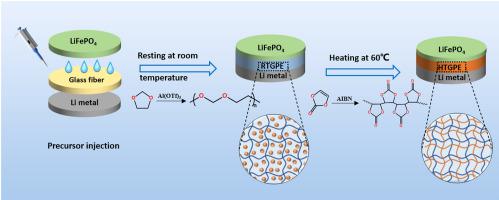Materials Today Energy ( IF 9.0 ) Pub Date : 2022-12-30 , DOI: 10.1016/j.mtener.2022.101239 Yueyue Wu , Jian Ma , Hao Jiang , Lulu Wang , Fan Zhang , Xuyong Feng , Hongfa Xiang

|
In-situ polymerization to prepare solid/quasi-solid electrolytes for lithium batteries has been extensively researched in recent years, owing to its unique superiority in achieving good physical contact with rigid electrodes. However, the uniformity of in-situ polymerized electrolytes at elevated temperatures remains a challenge, which may be influenced by the uneven heat distribution during polymerization. In this work, we demonstrate a novel confined in-situ polymerization method, which allows the fabricated electrolytes with dual polymer networks to enhance the electrolyte homogeneity. 1,3-Dioxolane (DOL) is firstly cationically polymerized at room temperature, and next vinylene carbonate (VC) is free-radically polymerized at an elevated temperature under the confinement effect of the poly (DOL) skeleton. Using this stepwise strategy, more uniform polymerization of VC under heating treatment can be achieved. The obtained quasi-solid polymer electrolyte possesses a high ionic conductivity at room temperature of 1.98 × 10−3 S/cm, relatively low activation energy of 0.13 V and an oxidation potential up to 4.3 V. Full cell employing LiFePO4 cathode, Li metal anode and the in-situ polymer electrolyte possesses an initial discharge capacity of 117 mAh/g at a charge/discharge rate of 2C, with a high capacity retention ratio of 92.1% after 1500 cycles, showing promising application prospects.
中文翻译:

聚(1,3-二氧戊环)和聚(碳酸亚乙烯酯)基准固态聚合物电解质的限域原位聚合,提高了锂金属电池的均匀性
原位聚合制备锂电池用固体/准固体电解质由于其在与刚性电极实现良好物理接触方面的独特优势,近年来得到了广泛的研究。然而,高温下原位聚合电解质的均匀性仍然是一个挑战,这可能受到聚合过程中不均匀热分布的影响。在这项工作中,我们展示了一种新型的受限原位聚合方法,该方法允许制造具有双聚合物网络的电解质以提高电解液的均匀性。1,3-二氧戊环 (DOL) 首先在室温下发生阳离子聚合,然后在聚 (DOL) 骨架的限制作用下,碳酸亚乙烯酯 (VC) 在升高的温度下发生自由基聚合。使用这种逐步策略,可以实现加热处理下 VC 的更均匀聚合。获得的准固态聚合物电解质在室温下具有 1.98 × 10-3 S/cm 的高离子电导率、0.13 V 的相对较低的活化能和高达 4.3 V 的氧化电位。采用 LiFePO4正极、Li 金属阳极和原位聚合物电解质在充电/放电速率为 2 时具有 117 mAh/g 的初始放电容量C,1500次循环后容量保持率高达92.1%,具有良好的应用前景。


















































 京公网安备 11010802027423号
京公网安备 11010802027423号